|
|
|
| |
| This
is the first of three features (read
Part II) that will focus on the Atlas II Transfer Case,
manufactured by Advance
Adapters. This feature will take a look at the advantages,
disadvantages, and reasoning behind choosing to install an Atlas
II in a moderately configured Jeep Wrangler TJ. The following
features will delve into the installation of the unit, and finally,
we will evaluate its performance on both road and trail. |
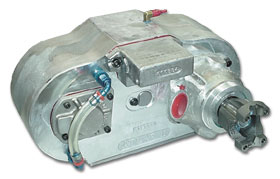 |
The
Holy Grail
The
Atlas II Transfer Case has come to be the "Holy
Grail" of performance transfer cases for recreational,
and competition four-wheelers. The gear-driven Atlas
II boasts superior strength and either 3.0:1, 3.8:1 or 4.33:1
gear reduction. Twin stick operation allows individual
control of front and rear axles on the trail. These
features, and more, help make the Atlas II Transfer
Case a favorite among serious four wheel drive enthusiasts. |
|
| We
chose the Atlas II for our application because it offers
exceptional strength, improved gear reduction, and individual
axle control. While other transfer case upgrade options
may be more cost-effective, the Atlas packs in a much
more comprehensive set of features in a new and ready-to-install
package.
The
case itself is a rock-solid, one piece design, machined
from 356-T6 Heat Treated Aluminum Alloy. The Atlas II
is 2.5 inches shorter than an NP231 with a short shaft
conversion kit. This will allow us to run a longer rear
driveshaft, and further reduce the potential for driveline
vibrations. Our transfer case is going to be equipped
with a 32 spline front output shaft and a stronger yoke,
which is common for 1/2 ton and 3/4 ton trucks. This
feature can be identified by a blue anodized front output
seal retainer.
| Final
Crawl Ratio Comparison * |
| 1999
TJ with NP231 |
TJ with Atlas II |
| 38.86:1 |
61.86:1 |
| AX-15,
3.73 |
AX-15,
3.73 |
|
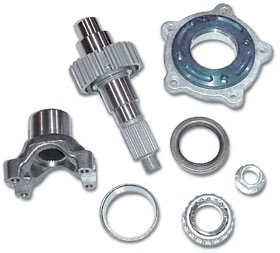 |
|
| 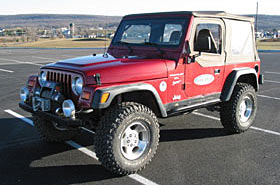
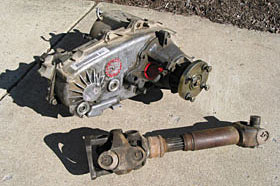
|
Equipment
Our
Atlas II is going to be mated to an AX-15 manual transmission
in a 1999 Jeep Wrangler, thus, it will be configured
with a left-hand drop, 4.33:1 reduction, a 23 spline
input, and a CV-1310 rear output. This setup typically
retails for around $2,400.00. In addition, we will be
adding a 32 spline front output with a CV-1310 yoke,
which adds another $300 to the total.
The
Atlas II will be replacing an NP231 Transfer Case equipped
with a Tom Wood Short Shaft Conversion. The NP231 is
a cast aluminum, two piece design, that has a low range
ratio of 2.72:1, and is chain driven as opposed to gear
driven. While the NP231 has proven dependable, it is
by no means bulletproof, and does not offer nearly as
much peace of mind as the Atlas II.
The
recipient TJ is equipped with approximately 2.75"
of suspension lift, 32" tires, and original 3.73
gears housed in Dana 30 and Dana 35c axles. The Atlas
II will be providing more than enough strength for this
application and will help provide a competitive crawl
ratio. Perhaps overkill for this vehicle configuration,
the Atlas II offers strength, performance, and room
to grow. If the hefty price tag fits within your budget,
you will likely be purchasing the last transfer case
you will ever need. |
|
| Gear
Reduction
The
primary feature that drew us to the Atlas II Transfer
Case is the 4.33:1 low range ratio. Our moderately-equipped
Jeep Wrangler is a relatively comfortable daily driver
with great high range gearing for all pavement conditions.
We do not plan on performing a ring and pinion swap
as long as the vehicle is equipped with 32" tires.
The Atlas II will allow us to keep the good street gearing,
but it will help provide a much-improved crawl ratio
for technical terrain.
Currently,
the NP231 with our transmission, and differential gear
ratio provides an ultimate crawl ratio of 39.86:1. Enter
oversize tires into the equation and this ratio can
quickly become inadequate. In terrain like that pictured
on the right, being able to effectively control your
slow speed is almost mandatory.
Not
being able to go slowly and carefully can result in
catastrophic damage. On the other hand, too much use
of the clutch in such a situation might result in temporary,
or permanent clutch failure. One needs to be able to
keep the speed to an absolute minimum with little, or
preferably no use of the clutch.
With
proper low gearing for extreme terrain, the driver can
pay more attention to steering and watching the spotter,
and pay less attention to speed control and keeping
the engine alive. Our Atlas II will provide us with
an ultimate crawl ratio of 62:1, which brings us closer
to blissful rockcrawling. While 62:1 isn't "extreme
granny" by today's standards, it is very good,
and considerably better than stock. |
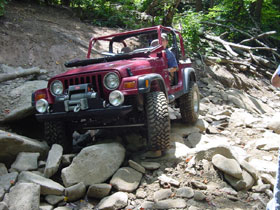
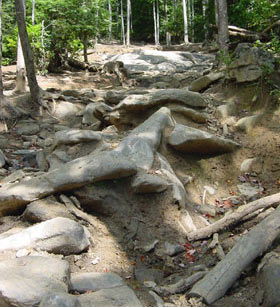
|
|
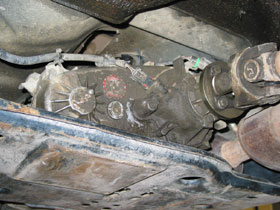
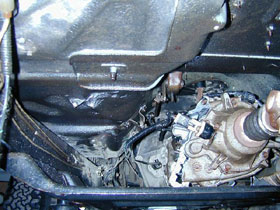
Photo:
Michael McCready
|
Strength
Overall
strength is the other feature that makes the Atlas II
transfer case so appealing.
The
cast aluminum split case design is no doubt the weakest
characteristic of the NP231 transfer case. A common
problem that many older NP231 transfer cases experience
is a cracked housing, which can mainly be attributed
to fatigue. These transfer cases can also easily be
destroyed by the front axle being rammed with exceptional
force. As a result, the front driveshaft over-compresses
and breaks through the front output section of the transfer
case. General internal failure, although uncommon, can
also cause an NP231 to be blown apart, as shown in the
picture on the left.
The
rock solid Atlas II transfer case weighs in at 110 lbs
(dry), which is approximately 40 lbs heavier than the
NP231. The case isn't just strong on the outside, though.
The internal workings of the Atlas II are complimented
by large helical-cut gears, and an assortment of heavy
duty components. Most chains, in chain-driven transfer
cases, are prone to stretching out over time, but this
gear-driven alternative will likely last forever.
The
Atlas II is built to be used and can easily cope with
the rigors of serious four-wheeling.
Continued
--->>> |
|
|
|